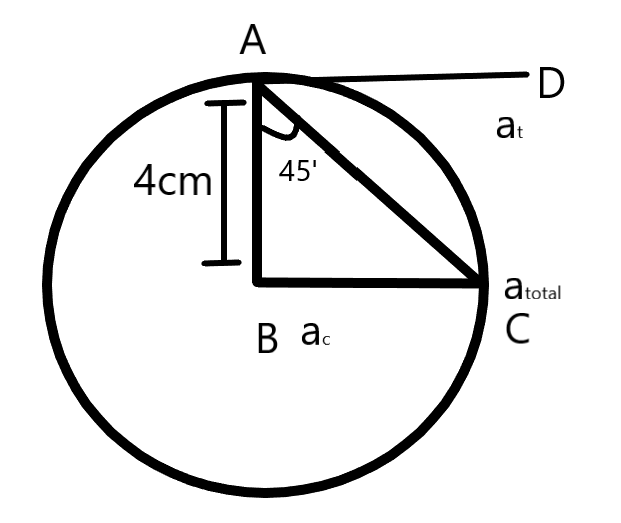
Answer
376.8k+ views
Hint: We know that the radial acceleration is equal to the rate of change in velocity . The change which generates in speed during the non uniform circular motion known as tangential acceleration.
Complete step-by-step solution:
let's draw a diagram of this question to solve this question-

here in this problem , tangential acceleration = \[9m/{{s}^{2}}\]
Radius =\[4m\]
from the fig we get triangle ABC ,
\[\begin{align}
& \tan {{45}^{\circ }}\Rightarrow \dfrac{at}{ac} \\
& or,1\Rightarrow \dfrac{9}{ac} \\
& or,ac\Rightarrow 9m/{{s}^{2}} \\
\end{align}\]
Now , we know that tangential acceleration is
\[at\Rightarrow \dfrac{dv}{dt}\]
\[or,dv\Rightarrow at.dt\]
\[or,\int_{0}^{v}{dv\Rightarrow \int\limits_{0}^{t}{9dt}}\]
\[or,v\Rightarrow 9t\] \[m/s\]
Again , we know that centripetal acceleration \[\left( ac \right)=\dfrac{{{v}^{2}}}{r}\]
Now , using \[(ac)=(at)\] we get
\[\dfrac{{{v}^{2}}}{r}\Rightarrow \dfrac{dv}{dt}\]
\[or,\dfrac{{{(9t)}^{2}}}{4}\Rightarrow 9\]
\[or,\dfrac{81t}{4}\Rightarrow 9\]
\[or,{{1}^{2}}\Rightarrow \dfrac{4}{9}\]
\[or,t\Rightarrow \dfrac{2}{3}\sec \]
Therefore, the correct option is B) \[\dfrac{2}{3}s\].
Note: During circular motion the speed vector changes its direction at each point on the circle . This suggests that the tangential component of acceleration is always non-zero.
Complete step-by-step solution:
let's draw a diagram of this question to solve this question-

here in this problem , tangential acceleration = \[9m/{{s}^{2}}\]
Radius =\[4m\]
from the fig we get triangle ABC ,
\[\begin{align}
& \tan {{45}^{\circ }}\Rightarrow \dfrac{at}{ac} \\
& or,1\Rightarrow \dfrac{9}{ac} \\
& or,ac\Rightarrow 9m/{{s}^{2}} \\
\end{align}\]
Now , we know that tangential acceleration is
\[at\Rightarrow \dfrac{dv}{dt}\]
\[or,dv\Rightarrow at.dt\]
\[or,\int_{0}^{v}{dv\Rightarrow \int\limits_{0}^{t}{9dt}}\]
\[or,v\Rightarrow 9t\] \[m/s\]
Again , we know that centripetal acceleration \[\left( ac \right)=\dfrac{{{v}^{2}}}{r}\]
Now , using \[(ac)=(at)\] we get
\[\dfrac{{{v}^{2}}}{r}\Rightarrow \dfrac{dv}{dt}\]
\[or,\dfrac{{{(9t)}^{2}}}{4}\Rightarrow 9\]
\[or,\dfrac{81t}{4}\Rightarrow 9\]
\[or,{{1}^{2}}\Rightarrow \dfrac{4}{9}\]
\[or,t\Rightarrow \dfrac{2}{3}\sec \]
Therefore, the correct option is B) \[\dfrac{2}{3}s\].
Note: During circular motion the speed vector changes its direction at each point on the circle . This suggests that the tangential component of acceleration is always non-zero.
Recently Updated Pages
How many sigma and pi bonds are present in HCequiv class 11 chemistry CBSE

Mark and label the given geoinformation on the outline class 11 social science CBSE

When people say No pun intended what does that mea class 8 english CBSE

Name the states which share their boundary with Indias class 9 social science CBSE

Give an account of the Northern Plains of India class 9 social science CBSE

Change the following sentences into negative and interrogative class 10 english CBSE

Trending doubts
Fill the blanks with the suitable prepositions 1 The class 9 english CBSE

The Equation xxx + 2 is Satisfied when x is Equal to Class 10 Maths

In Indian rupees 1 trillion is equal to how many c class 8 maths CBSE

Which are the Top 10 Largest Countries of the World?

How do you graph the function fx 4x class 9 maths CBSE

Give 10 examples for herbs , shrubs , climbers , creepers

Difference Between Plant Cell and Animal Cell

Difference between Prokaryotic cell and Eukaryotic class 11 biology CBSE

Why is there a time difference of about 5 hours between class 10 social science CBSE



